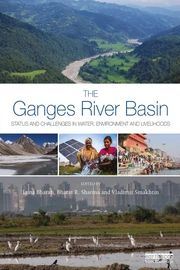New insights into the Ganges river basin
October 17, 2016.
New book presents an overview of the challenges facing the critically important Ganges river as a water resource for 500 million people
The Ganges River Basin spans China, Nepal, India and Bangladesh. With a catchment area of nearly 1.1 million km2, the Ganges basin supports more than 500 million people in agriculture-based civilizations in South Asia who value the Ganges not only for irrigation, drinking water and energy production but also have a spiritual and emotional connection to the river as the Ganges is considered sacred in Hindu scriptures.
A recently published <link https: www.routledge.com the-ganges-river-basin-status-and-challenges-in-water-environment-and bharati-sharma-smakhtin p book>book presents the first comprehensive overview of the key issues and challenges facing the Basin region. “The Ganges is a transboundary basin primarily shared amongst Nepal, India and Bangladesh, with an estimated 4% of the catchment in China,” said Luna Bharati, the lead editor, who is a principal researcher with the International Water Management Institute (IWMI), based in the Center for Development Research (ZEF), Germany. “In this book, we have made an attempt to comprehensively cover the various aspects of the Ganges basin from a bio-physical, socio-economic and political perspective. Each chapter was jointly written by authors from the main riparian countries. The various chapters therefore also represent unique country specific views, which for certain topics such as hydropower or transboundary relations were quite diverse and sometimes contradictory. The contributing authors also represented a multitude of regional institutions so the book is also an excellent example of transboundary and trans disciplinary cooperation among regional scientists and institutions.”
The three parts of the book cover resources and uses, the environment, and governance and livelihoods. Contributions assess the status and trends of water resources, including the Himalayas, groundwater, pollution, floods, drought and climate change. They describe livelihood systems in the basin, and the social, economic, geopolitical and institutional constraints, including transboundary disputes, to achieving productive, sustainable and equitable water access. Management of the main water-use sectors and their inter-linkages are reviewed, as well as the sustainability and trade-offs in conservation of natural systems and resource development such as for hydropower or agriculture.
This book is being published at a time when there is strong national and global interest in improving the health, freshwater environment and benefits from this unique river system providing sustenance to millions of poor population spread across the riparian countries. It is published at the time when countries unite globally to reach Sustainable Development Goals of 2030, and improve global, regional and national water security. “We are hopeful that this neutral, candid and science-based book will be interesting to policymakers, the private sector, the donor community and the general public who have an interest in and respect for the Ganga,” said Vladimir Smakhtin, Director of the United Nations University Institute for Water, Environment and Health.
<link https: www.routledge.com the-ganges-river-basin-status-and-challenges-in-water-environment-and bharati-sharma-smakhtin p book external-link-new-window external link in new>More information about the book.



